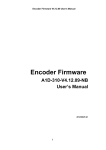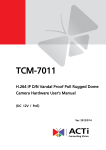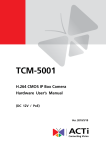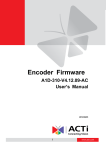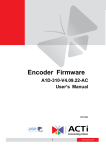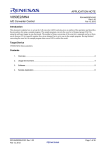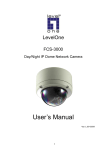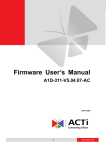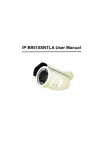Download Encoder Firmware User`s Manual
Transcript
Encoder Firmware A1D-310-V4.05.13-AC User’s Manual i Table of Contents 1. Recommended PC Specification _____________________________________ 3 2. Preparation before setup ___________________________________________ 4 2.1. 3. Configuring the IP device __________________________________________ 9 3.1. Login____________________________________________________________ 9 3.2. Live view _______________________________________________________ 11 3.3. Host____________________________________________________________ 14 3.3.1. Host Setting __________________________________________________________ 14 3.3.2. Date & Time Setting ___________________________________________________ 15 3.4. Network ________________________________________________________ 18 3.4.1. Network link speed & duplex mode _______________________________________ 18 3.4.2. Connection Type ______________________________________________________ 19 3.4.3. IP Address Filtering ____________________________________________________ 21 3.4.4. DNS ________________________________________________________________ 21 3.4.5. DDNS ______________________________________________________________ 21 3.4.6. Port Mapping _________________________________________________________ 23 3.4.7. ToS ________________________________________________________________ 24 3.4.8. UPnPTM _____________________________________________________________ 26 3.5. Video & Audio ___________________________________________________ 27 3.5.1. Basic _______________________________________________________________ 27 3.5.2. Advance(CMOS Mega Pixel Camera)______________________________________ 29 3.5.3. Advance(CCD Mega Pixel Camera) _______________________________________ 34 3.5.4. Advance(Video Server) _________________________________________________ 34 3.5.5. Media 1&2 ___________________________________________________________ 37 3.6. ii Setup your PC network ____________________________________________ 4 Maintain ________________________________________________________ 40 3.6.1. User Account Setting\ __________________________________________________ 41 3.6.2. System Info __________________________________________________________ 41 3.6.3. Factory Default _______________________________________________________ 43 3.6.4. Firmware Upgrade _____________________________________________________ 43 3.6.5. Reboot and Save & Reboot ______________________________________________ 45 3.6.6. Logout ______________________________________________________________ 46 1. Recommended PC Specification CPU Core2Duo 2.13GHz Hard Disk 40 GB or above Memory 2 GB or above Operating System Windows XP with SP2 or above. IE6.0 SP2. IE7.0 only. Video Resolution SVGA or XGA with 1024x768 resolution 3 2. Preparation before setup Our IP device provides access through Internet Explorer. You need to set up the network settings and the IP address for the IP device. Please make sure all connections are properly connected, then follow the provedures below. 1. Setup your PC network The IP address for your PC must be within the same subnet as the IP device. You need to match the TCP/IP settings between PC and IP device before you can access it via IE. 2. Setup IP device’s IP address This IP device’s IP address can be assigned manually or acquired automatically by network service (DHCP). If it acquires the IP address by using the DHCP service, please use the IP utility software bundled in the product CD to find the IP address for all IP devices 2.1. Setup your PC network To set up the network of IP device via a PC, you have to change the TCP/IP settings of the PC. The following are the default network settings of IP device. IP Address: 192.168.0.100 Subnet Mask: 255.255.255.0 To access the IP device, the IP address of the PC should match the address below. IP Address: 192.168.0.xxx Subnet Mask: 255.255.255.0 NOTE: xxx should be a number from 1 to 254 except 100, which is used by the IP device. Please also make sure that no two equipments use the same IP address in the same network. The procedures below is the setup procedure on Windows XP. If you use 4 operating system other than Windows XP, please refer to OS manuals for proper setup procedures. 5 STEP1 Start up your PC. STEP2 Click the [Start] and select the "Control Panel" STEP3 Double-click the "Network and Internet connections" icon. STEP4 Double-click the "Network connections" icon 6 STEP5 Click “Local Area Connections”, and then click “Change settings of this connection” in the network Task menu. STEP6 Click “Internet Protocol (TCP/IP)”, and then click the [Properties] button. 7 STEP7 Click the “Use the following IP address” radio button and enter the IP address and the subnet mask. Please set the settings as below. IP address: 192.168. 0.xxx Subnet mask: 255.255.255. 0 (NOTE: xxx should be a number from 1 to 254 except 100, which is used by the IP device. Please also make sure that no two equipments use the same IP address in the same network..) STEP8 Click the [OK] button and the window dialog box closes. 8 3. Configuring the IP device This section describes how to configure the IP device. The administrator has unlimited access to all settings, while the normal user can only view live video. The IP device is configured under a standard browser (Microsoft Internet Explorer 6.0 or above). 3.1. Login This section tell you the procedures to login the IP device. STEP1: Open a browser STEP2: Enter the IP address of the IP device. The default IP address is “192.168.0.100” The “Login Page” is now displayed as below. STEP3: Enter the Account name (factory default: admin) and the Password (factory default: 123456). NOTE: Internet Explorer 6.0 or above is highly recommended. You may download it from http://www.microsoft.com/windows/ie/downloads/default.mspx 9 STEP4: Select the language of the IP device user interface. You can select between English, Traditional Chinese, Japanese, Spanish, Italian, German, Portuguese, Greek, Dutch, Russia, Turkey, Indonesia and Swedish. This user interface setting will disappear once you log out, if you want to change the default user interface language, please change the setting of [Host] in the “Host & Date” section after login. STEP5: Click the button to login or click the button to re-enter again. Once successfully logged in, the “Live page” will be displayed as below. 10 3.2. Live view This section tells you how to view live images via Internet Explorer. STEP1: Click the [Live] tab to show [Live page]. The “Live page” is displayed as below. STEP2: Please refer to table below for how to use these functions 11 Function List Function Full Screen SnapShot Audio out Media Description Click the icon to stretch the preview to full screen. You can click “Esc” button on the keyboard to return to previous display. Click the icon “ ” to take a snapshot . The snapshot picture will be saved to the default folder “C:\Users\”account name”\Picture”, in the format of YYYYMMDD_HH_mm_ss.jpg. Click the icon to enable the audio from PC to IP camera or video server. When it is enabled, your voice will be transferred to the audio out of the IP camera or video server. NOTE: you will need to have a microphone connected to your PC to do that. If dual stream mode is enabled, click to select media stream 1 or media stream 2 to display. The default is single stream only. To change to dual stream mode please refer to “Media 1” section under “Setup” tab Click Encoder Type to select the Encoder type. The Encoder type option includes MPEG-4, MJPEG and H.264. Once selected, the video server/IP camera will start to send video in new stream type. Click or of to adjust display screen size Display screen size Audio in Click the icon to to mute or the icon to display audio from the video server/IP camera. You can drag the volume bar 12 to adjust the volume to display. Digital Zoom Digital zoom enables you to zoom-in the image. You can click to zoom in and click to zoom out. You can click the to cancel all zoom-in and go back to original status (no zoom status). When you digitally zoom-in the video, you can click to pan/tilt the video up, down, left and right. NOTE: This pan/tilt function does not work if the video is not zoomed-in (no zoom status). Network status indicate the network state. If the light on the right is green, it mean the network is ok. If the light is gray, it means the network is broken. The light on the left is not used DO Setting Click on Events. Click to enable DO output from Camera to Disable DO output on Event. STEP2: If you want to setup this IP camera/video server, please click the [Setup] tab to switch to “Setup Page”. The “Setup Page” will display as below. 13 NOTE: If the streaming is disabled, you cannot see the live images here. 3.3. Host Click the [Host] item on the “Setup Page”. 3.3.1. Host Setting This section tells you how to setup IP device’s host settings. STEP1: Click the [Host] to enter the Host settings. The “Host Setting Page” is displayed as below. 14 STEP2: Please refer to table below for how to use these functions Host setting Description Parameters Host name Language Enter a host name, and this host name will be shown when you use the IP utility or the SDK to search for the IP device. Select the language of default user-interface. Each user login will see the default user-interface first. Camera name The camera name is reserved for customer use. STEP3: Click the settings or click the [Apply] button of each setting to confirm the [Reset] button to re-enter the parameters. 3.3.2. Date & Time Setting This section tells you how to setup IP device’s date and time settings. STEP1: Click the [Date & Time] item of host category on the “Setup Page” The “Date & Time Setting Page” is displayed as below. 15 16 STEP2: Configure these settings with reference to the table below. Date Setting Parameters SNTP/NTP server Description Click this to enable IP device’s SNTP/NTP function. SNTP/NTP function enables this IP device to synchronize its time settings with a SNTP/NTP server. You can use this function to make sure all your IP devices’ time is the same. Additionally, with our embedded digital-time-code in the streaming, you can tell the event sequence accurately. IP address: Enter the IP address of the SNTP/NTP server. Sync time: Select the time interval for this IP device to synchronize its time. Click this to manually setup the date & time. Date : Select the date Set manually Time zone Day Light Saving Time: Select the time Select the time zone offset for local settings Select Type 1 to specify daylight saving time by week number in a month; select Type 2 to specify daylight saving time by date. Start Time : Select the daylight savings start time. End Time : Select the daylight savings end time. STEP3: Click the settings or click the 17 [Apply] button of each setting to confirm the [Reset] button to re-enter the parameters. 3.4. Network Click the [Network] item on the “Setup Page”. 3.4.1. Network link speed & duplex mode This section tells you how to setup IP device’s network link speed and mode STEP1: Click the [Link Speed & Duplex Mode] item of network category on the “Setup Page” The “Link Speed & Duplex Mode Setting Page” is displayed as below. 18 STEP2: Please refer to table below for how to use these functions Network link speed & duplex Parameters Description This item lets you select the network transmission speed of WAN port. You can select from 1. Auto detect (default setting) 2. 100Mbps / Full duplex WAN speed 3. 100Mbps / Half duplex 4. 10Mbps / Full duplex 5. 10Mbps / Half duplex STEP3: Click the settings or click the [Apply] button of each setting to confirm the [Reset] button to re-enter the parameters. 3.4.2. Connection Type This section tells you how to setup IP device’s connection type of network. STEP1: Click the [Connection Type] item. The “Connection Type Page” is displayed as below. 19 STEP2: Please refer to table below for how to use these functions. WAN Setting Parameters Description Click this to enable IP device’s DHCP function. Dynamic IP It will acquire its WAN port IP address from a DHCP server within the same network. (You must have a DHCP address server in order to enable this function.) Click this to manually enter the IP device WAN port IP address. IP address: Enter the WAN port IP address. Static IP address Subnet mask: Enter the subnet mask of WAN port. If IP address is changed, adjust the subnet mask accordingly. ISP gateway: Enter the IP address of the gateway (the router). Click this when you connect IP device directly to the xDSL modem. User name: Enter the user name of your xDSL account. Password: Enter the password of your xDSL account. PPPoE IPV6 Note: You have to click the [Save Reboot] after you click the [Apply button] to let this IP device start xDSL connections. Click the check box to support IPV6 protocol STEP3: Click the settings or click the 20 [Apply] button of each setting to confirm the [Reset] button to re-enter the parameters. 3.4.3. IP Address Filtering This section tells you how to setup IP Address Filtering for this IP device. WARNING: Please be very careful when using this function, as you may lose access to your camera if you make mistakes in setup. You may either accidentaly deny yourself of access, or forgot to include your own IP address in the allowed address list. When you click the [IP Address Filter] item, the “IP Address Filter Page” is displayed as below. IP Address Filter Settings Parameters IP Address Filter Enable Filter Type 21 Description Check this box to enable IP Address Filtering. The filter can be set in either “Allow” mode or “Deny” mode. 1. “Allow” mode will refuse access to all IP addresses except the ones listed below. 2. “Deny” mode will accept all incoming access except the IP addresses listed below. Make sure you include the Netmask in your consideration. IP Address Netmask Enable Apply Reset The IP address you wish to allow or deny. Please note that the actual range is modified by the Netmask. Using Netmask allows you to set filtering for a whole range of IP address at once, without the need to enter all of them individually. If you are not sure about the function of netmask, then you should use 255.255.255.255, and it will affect only a single IP address per line of entry, or use 255.255.255.0 to use the same setting for all IP addresses starting with the same three numbers. . For each entry, you must check this box for it to be effective. For an entry that you no longer need but does not wish to delete, you can uncheck it, and the system will remember it for future use. If a new entry that has never been used before does not have Enable checked, then it will not be stored in memory. Click this to use the current displayed info to do IP Address filtering. If you setup correctly, it will change into a greyed out Success in a few seconds. Click this button to re-enter the parameters. 3.4.4. DNS This section tells you how to setup IP device’s DNS setting. STEP1: Click the [DNS] item. The “DNS Server Setting Page” is displayed as below. 22 STEP2: Please refer to table below for how to use these functions. DNS server Setting Parameters Primary DNS server Secondary DNS server Description Defines the IP address of the primary DNS server. This is used for identifying this computer by name instead of IP address. The IP address of the secondary DNS server. It will be used once the primary DNS server fails. STEP3: Click the settings or click the [Apply] button of each setting to confirm the [Reset] button to re-enter the parameters. 3.4.5. DDNS This section tells you how to setup IP device’s DDNS setting. STEP1: Click the [DDNS] item. The “DDNS Server Setting Page” is displayed as below. STEP2: Please refer to table below for how to use these functions. DDNS server Setting Parameters DDNS type Service ISP Host name User name 23 Description Click this to enable IP device’s DDNS function. DDNS function enables user to connect to this IP device by domain name even if its IP address is not static. Click one of the DDNS service providers. You can visit their website to get a DDNS service account for this IP device. Enter the host name of your DDNS service account. (ex: xxxx.dyndns.org) Enter the user name to login your DDNS service account. Password Enter the password to login your DDNS service account. STEP3: Click the settings or click the [Apply] button of each setting to confirm the [Reset] button to re-enter the parameters. 3.4.6. Port Mapping This section tells you how to setup IP device’s Port Mapping setting. STEP1: Click the [Port Mapping] item. The “Port Mapping Page” is displayed as below. STEP2: Please refer to table below for how to use these functions. Port Mapping Parameters Description Select the port assigned for HTTP protocol access HTTP port Select the port assigned for HTTPS protocol access HTTPS Select the first port used by server search applications to Search server port1 detect this IP device. (e.g. IP utlity) Select the first port used by server search applications to Search server port2 detect this IP device. (e.g. IP utlity) 24 Video control port Video streaming port (TCP Only) Video Multicast Port RTSP port RTP Multicast Video Port for Media1 RTP Multicast Audio Port for Media1 RTP Multicast Video Port for Media2 RTP Multicast Audio Port for Media2 Multicast IP Multicast TTL IGMP STEP3: Click the click the Select the port used to support video control function by application programs. (e.g. NVR) Select the port used by this IP device for Video Streaming. Enable/disable multicast audio streaming Select the port assigned for RTSP protocol access Select the port for the multicast video streaming of media1 via RTP protocol Select the port for the multicast audio streaming of media1 via RTP protocol Select the port for the multicast video streaming of media2 via RTP protocol Select the port for the multicast audio streaming of media2 via RTP protocol Select the multicast IP. Default settings is 228.5.6.1 Select the multicast TTL. Default setting is 255. Select video type connected to the video-in of this IP device. If you use an incorrect video type, some images might be lost. [Apply] button of each setting to confirm the settings or [Reset] button to re-enter the parameters. 3.4.7. ToS This section tells you how to setup IP device’s ToS(Type of Service) setting. Click the [ToS] item to see the “ToS Setting Page ” displayed as below. 25 STEP2: Please refer to table below for how to use these functions. ToS (Type of Service) Parameters Description Select whether to add the TOS tag onto the streaming data. TOS (type of Streaming data with a higher priority TOS tag will be transmitted first while compared with other data to be service) transmitted. Select the TOS tag’s priority to be added onto the streaming. You can select between 1.Minimize-Delay TOS priority 2.Maximize-throughout 3.Maximize-Reliability 4.Normal-Service STEP3: Click the settings or click the [Apply] button of each setting to confirm the [Reset] button to re-enter the parameters. 3.4.8. UPnPTM This section tells you how to setup IP device’s UPnPTM. STEP1: Click the [UPnPTM] item. The “UPnPTM Setting Page” is displayed as below. checkbox to enable or disable the UPnPTM function. Edit STEP2: Click the UPnP Friendly Name in text field STEP3: Click the or click the 26 . [Apply] button of each setting to confirm the settings [Reset] button to re-enter the parameters. 3.5. Video & Audio Click the [Video & Audio] item on the “Setup Page”. 3.5.1. Basic This section tells you how to setup IP device’s video and streaming settings. STEP1: Click the [Video & Audio] item. The “Video & Audio Basic setting Page” is displayed as below. 27 STEP2: Please refer to table below for how to use these functions Video & Audio Basic Setting Parameters Description You can use this setting to limit the preview time in the Live Display Page.This function applies for user who logged in to this IP device to view the video. Maximum Stream Time If the Maximum stream time is 0, this function will be disabled and there’s no limit on Live Display page preview. RTSP Authen Checkbox to enable RTP streaming’s Account/Password authentication. Enable RTP B2 Checkbox to enable the B2 frame in RTP streaming Frame Enable Select enable or disable the audio function. Audio Input Select HIGH or LOW of the audio input sensitivity Sensitivity Audio Out Select enable or disable the audio function. Volume STEP3: Click the settings or click the 28 [Apply] button of each setting to confirm the [Reset] button to re-enter the parameters. 3.5.2. Advance(CMOS Mega Pixel Camera) This section tells you how to setup motion detection and camera setting STEP1: Click the [Advance] item. The “Advance Setting Page” is displayed as below. STEP2: Click the Plus sign to expand the Motion Detection settings, then Click 29 checkbox to enable motion detection function setting The Motion detection region and Motion detection settings will be displayed as below. 30 STEP3: Click the individual region. STEP4: Click one region to start to edit its size and location. You can click the “Adjust Column” to drag motion region to your desired location. You can click the “Adjust Square” and drag to adjust motion region size. You can click the upper right button to cancel this motion region. Repeat above procedure to adjust the motion region. STEP5: Set the STEP6: Set the interval time of motion detection. After a motion event is triggered, no more event will be triggered within this time in the same region STEP7: Set the trigger threshold of motion detection region. The larger this value, the larger the object size needed to trigger motion detection. checkbox to enable motion detection for each sensitivity of motion detection region. STEP8: In motion activity window , the bar shows the motion activitiy status. You can also see the trigger threshold (Red line). When the motion activity exceeds the trigger threshold, the bar would become red to indicate that a motion event hs been triggered. While viewing the motion activitity window, you can adjust the motion sensitivity (the higher, the easier camera considers video change to be an activity) and the threshold (the higher, the larger the activity needed to trigger a motion event) If the default settings are not satisfactory for your scene, you may try our alternative recommendations of: a. Sensitivity: 80, Threshold: 2~5 (for normal environment) b. Sensitivity: 80, Threshold: 5~10 (for very noisy environment) The “Camera Setting Page” is displayed as STEP9: Please refer to table below for how to use these functions Camera setting Parameters Video Flipping Check this box to flip the video up-down Video Mirror Lens Compensation Check this box to mirror the video left-right Night Gain Threshold 31 Description Check this box to use best pre-set settings for bundled lens This value controls the level of light where camera switches into night mode. Increasing it will make camera switch to night mode at a darker illumination level. Sharpness Line frequency White Balance Mode R Gain (Manual White balance mode only) B Gain (Manual White balance mode only) Select the sharpness value Change settings between 60Hz or 50Hz, depending on the AC power type of your region. Select the white balance mode. You need to wait for 5~10seconds to see the final result. 1. AUTO : Auto white balance (default) 2. INDOOR1: Select the indoor white balance profile 1. 3. INDOOR2: Select the indoor white balance profile 2. 4. OUTDOOR1: Select the outdoor white balance profile 1. 5. OUTDOOR2: Select the outdoor white balance profile 2 6. HOLD CURRENT: Select this to let the IP camera automatically obtain a best white balance setting according to current environment. The IP camera will use this setting to adjust color. NOTE: This setting will be lost after you reboot the camera. 7. MANUAL: Select this to enable manual setting of the white balance. You will need to enter the R Gain and B gain setting below. Add or decrease redness to the video when under Manual White Balance mode. (This function is only available in Manual White balance mode.) Add or decrease blueness to the video when under Manual White Balance mode. (This function is only available in Manual White balance mode.) Select exposure mode to auto or manual. 1. Auto: The IP camera will adjust the exposure automatically. Exposure mode 2. Manual: (In Manual White balance mode only) Manually select the Exposure Gain and Shutter Speed below. AGC Gain When exposure mode is auto, IP camera will adjust (In auto its shutter speed according to AGC gain and the Exposure mode Maximum auto shutter speed. Higher AGC gain = brighter images. only) Exposure Gain (In Manual Select the exposure Gain of the IP camera. The Exposure Mode higher the value = brighter images. only) 32 Shutter Speed (In Manual Exposure Mode only) Flickless Mode Maximum Auto Shutter Speed (In auto Exposure mode only) Brightness 33 Increase or decrease the shutter speed. The closer the number is to 1, the better nighttime performance is, although this also causes motion blur to the video. Enable the flickless or disable the flickless mode. When exposure mode is auto, IP camera will adjust its shutter speed according to AGC gain and the Maximum auto shutter speed. This setting is to set the maximum shutter speed range of this camera. Select the brightness value Saturation Select the saturation value Contrast Select the contrast value STEP10: Click the [Apply] button of each setting to confirm the settings or click the [Reset] button to re-enter the parameters. 3.5.3. Advance(CCD Mega Pixel Camera) This section tells you how to setup camera setting of CCD megapixel camera ( Motion Detection setting is the same as CMOS camera) STEP1: Click the [Advance] item. The “Camera Setting Page” is displayed as below STEP2: Adjust the settings as per the following table Camera setting Parameters 34 Description Mirror Mode Check this box to flip the video up-down Flip Mode Check this box to mirror the video left-right White Balance Mode Select the white balance mode. After you set the parameter, you need to wait for 5~10seconds to see the final result. 1. AUTO : Auto white balance (default) 2. INDOOR1: Select the indoor white balance 3. 4. 5. 6. 7. R Gain (Manual White balance mode only) B Gain (Manual White balance mode only) profile 1. INDOOR2: Select the indoor white balance profile 2. OUTDOOR1: Select the outdoor white balance profile 1. OUTDOOR2: Select the outdoor white balance profile 2 HOLD CURRENT: Select this to let the IP camera automatically obtain a best white balance setting according to current environment. The IP camera will use this setting to adjust color. NOTE: This setting will be lost after you reboot the camera. MANUAL: Select this to enable manual setting of the white balance. You will need to enter the R Gain and B Gain setting below. Add or decrease redness to the video when under Manual White Balance mode. (This function is only available in Manual White balance mode.) Add or decrease blueness to the video when under Manual White Balance mode. (This function is only available in Manual White balance mode.) Select the day/night mode. 1. Auto: The camera would switch between day and night mode automatically. It will follow the Day Gain and Night Gain threshold defined by user below. Day/Night mode 2. Day : The camera will stay in day (color) mode. 3. Night: The camera will stay in night (black & white) mode. This value controls the level of light where camera Day Gain switches into day mode. Increasing it will make camera switch to day mode at a darker illumination Threshold level. This value controls the level of light where camera Night Gain switches into night mode. Increasing it will make Threshold camera switch to night mode at a darker illumination level. Change settings between 60Hz or 50Hz, depending Line Freqeuency on the AC power type of your region.. BLC Mode Enable or disable the back light compensation mode. Select exposure mode to auto or manual. Exposure mode 1. Auto: The IP camera will adjust the exposure 35 automatically. 2. Manual: (In Manual White balance mode only) Manually select the Exposure Gain and Shutter Speed below.. Flickless Mode Enable the flickless or disable the flickerless mode Select DC IRIS mode to auto or off. 1. Auto: The IP camera will adjust the Iris DC-Iris mode automatically. 2. Off: The iris is fixed. AGC Gain When exposure mode is auto, IP camera will adjust its shutter speed according to AGC gain and the (In auto Exposure mode Maximum auto shutter speed. Higher AGC gain = brighter images. only) Select exposure mode to auto or manual. 1. Auto: The IP camera will adjust the shutter automatically. Shutter mode 2. Manual: Manually select the Shutter Speed below. When exposure mode and shutter mode are auto, IP Maximum camera will adjust its shutter speed according to Shutter Speed AGC gain and the Maximum auto shutter speed. This (In auto shutter setting is to set the maximum shutter speed range of mode only) this camera. Exposure Gain Select the exposure Gain of the IP camera. The (In Manual Exposure Mode higher the value = brighter images. only) Shutter Speed Increase or decrease the shutter speed. The closer (In manually the number is to 1, the better nighttime performance shutter mode is, although this also causes motion blur to the video. only) Select the brightness value Brightness STEP2: Click the settings or click the 36 [Apply] button of each setting to confirm the [Reset] button to re-enter the parameters. 3.5.4. Advance(Video Server) This section tells you how to setup the Advance settings of H.264 Video Servers. (Motion Detection setting is the same as CMOS camera). STEP1: Click the [Advance] item. The “Advance Settings Page” is displayed as below STEP2: Adjust the settings as per the following table Adcance settings Parameters Deinterlace Digital Noise Reduction Black Level Extension 37 Description Select the method used for calculating video deinterlacing 1. 3D deinterlacing: Provides clearer image when movement speed within view is moderate 2. Intra : Provides clearer moving edge but at lower clarity. Choose to enable or disable Digital Noise Reduction Choose to turn Black Level Extension on, off or use manual setting. Black level extension will Brightness automatically shift the darkest part of the scene to completely dark, thus increasing maximum available contrast. Automatically detects skin color, and softens theimage around skin area to cover skin blemishes. Can be turned on, off or use manual settings. Use this to enhance image sharpness. User may turn this on, off or manual settings. Modulates overly bright or dark areas, so that you can see detail at extreme ends of illumination. Can be turned Off, On or use manual settings. Select the brightness value Saturation Select the saturation value Contrast Select the contrast value Skin Tone Enhancement Sharpness WDR Color Mode STEP2: Click the settings or click the [Apply] button of each setting to confirm the [Reset] button to re-enter the parameters. 3.5.5. Media 1&2 This section tells you how to setup IP device’s video and streaming settings. STEP1: Click the [Media 1] or [Media 2] item. The “Media 1 Setting Page” is displayed as below. 38 STEP2: Please refer to table below for how to use these functions Video setting Parameters Stream Mode Encoder Type Resolution Frame rate Video Bit Rate Mode Video Max Bitrate Bitrate Quality 39 Description Select the encoder’s streaming mode. 1. Dual Stream Mode: In this mode, the IP camera/video server can send two types of streams with different configurations including. resolution, frame rate, compression type, bit rate. You can setup each stream in [Media 1] and [Media 2]. 2. Single Stream Mode: In this mode, the IP camera/video server will send streams with the same configuration including resolution, frame rate, compression type, bit rate. Select the encoder’s compression type. 1. MPEG-4: The IP camera/video server will start to send stream in MPEG-4 format. 2. MJPEG: The IP camera/video server will start to send stream in MJPEG format 3. H.264: The IP camera/video server will start to send stream in H.264 format Select the video resolution of the IP device. Select the frame ratio by clicking and dragging the frame ratio red stick. Click [Apply] to update and see new frame rate. Select the video bitrate mode. Constant Bit Rate: The streaming’s bitrate remains constant at all conditions. Variable Bit Rate:: The streaming’s bitrate will variants according to the images variability to keep the image quality good. Select the Maximum bitrate of the video straming. Designating a limited bit rate may reduce frame rate. Doing so will also disable Bit Rate setting below. Select the bit rate of the video streaming. You can select from 28Kbps to 6Mbps. Note: Lower bit rate consumes less bandwidth but delivers lower quality images. High bit rate consumes more bandwidth but delivers higher quality images. 1. When encoder type is MJPEG: Select the quality value of MJPEG encoder type from 1 to 100. 2. STEP3: Click the or click the When encoder type is MPEG4 or H.264, and video bitrate mode is “Variable Bit Rate” Select the quality value from High Middle Low [Apply] button of each setting to confirm the settings [Reset] button to re-enter the parameters. 3.6. Maintain This sections let you obtain system information, maintain the device firmware and reboot the camera. Click the [Maintain] item on the “Setup Page”. 3.6.1. User Account Setting This section tells you how to setup the accounts STEP1: Click the [User Account Setting] item. The “User Account Setting Page” is displayed as below 40 STEP2: Setup the account names and their respective passwords. There are 1 root (administrator) account and 10 common user accounts. Administrator account allows the user to watch the live view and setup everything; but common user account allows user only to watch the live image. STEP3:Click the check box to enable “Anonymous preview”. When it is enabled, user can login this camera to view video without input account and password. But user will be required to input account and password if they want to change any setting STEP4: Click the settings or click the [Apply] button of each setting to confirm the [Reset] button to re-enter the parameters. 3.6.2. System Info This section tells you how to see the system information of this IP device including system information, WAN status and system log. STEP1: Click the [System Info] item. The “System information page” is displayed as below 41 STEP2: View the information at the 3 textboxs. This information is very useful to understand the IP device status and to resolve any problem that might occur. System info Column System info WAN status System log Description It shows the firmware version, MAC address, production ID, and factory default type of IP device. It shows the WAN port’s IP address, netmask, gateway, DNS server, DDNS host and connection status. It shows the system event. This column is very useful to as a diagnostic tool. STEP3: Click [Parameter List] where you may see all configurations of the IP device. 42 STEP4: Click [Server Report] to export related information of the IP device while reporting a support to your support channel. 3.6.3. Factory Default This section tells you how to load IP device’s factory default setting STEP1: Click the [Factory Default] item. The “Factory Default Setting Page” is displayed as below STEP2: If you want to keep network settings and load other settings to factory default, please click radio box. If you click instead , all the settings would be lost. You will have to use factory default IP setting to connect to this camera. Please refer to previous login section. STEP3 :If you want to reset all setting to default, click STEP4: Click the [Apply] button to show a warning dialog that remind you again execute the factory default. radio box. 3.6.4. Firmware Upgrade This section tells you how to see upgrade IP device’s firmware. You can always visit our web site for the latest firmware. STEP1: Click the [Firmware Upgrade] item. The “Firmware Upgrade Page-1” is displayed as below 43 STEP2: Click [Apply] button. The ‘’Firmware Upgrade Page-2” will be displayed as below. STEP3: Click the [Browse] to select the upgrade image file and click the [enter]. You can always get the latest version at our website. STEP4:Click the STEP5: The upgrade process window shows a progress bar indicating [Apply] button to start upgrading upgrade status. You can click the upgrade. 44 [Cancel] to stop the firmware STEP6: The progress bar shows the upgrading is completed, and system is rebooting. NOTE: If you cancel the firmware upgrade during upgrade process, the browser will close itself. 3.6.5. Reboot and Save & Reboot This section tells you how to save all the settings and reboot this IP device. This is critical because some settings might not take effect before save and reboot. STEP1: Click the [Reboot] or [Save and reboot] item of [Maintain] group on the “Setup Page”page”. The “Reboot” is displayed as below. 45 STEP2: The Action LED indicator will light down to indicate that the IP device is rebooting. After around 30 seconds, the Action LED will light up again to indicate that the reboot is completed. 3.6.6. Logout This section tells you how to logout the IP device. Be sure to logout this IP device once your setting is completed. 46 STEP1: Click the [Logout] item on “Setup Page” to logout from this device. You will logout and close the browser window.


















































